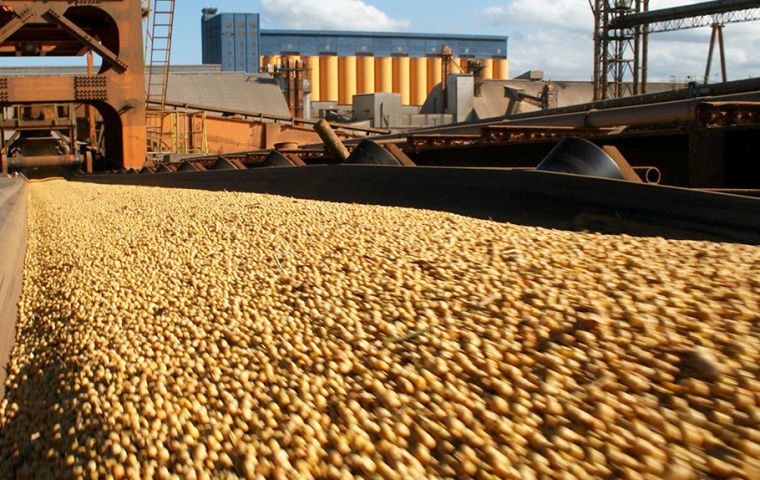MercoPress. South Atlantic News Agency
Brazil's 2016/17 crop reached 238.7 million tons: 114 million tons of soybean
 Projection is that Brazilian soybean production will decline from 113.93 million tons of soybeans in the 2016-2017 harvest to 107 million tons in the 2017-2018 harvest.
Projection is that Brazilian soybean production will decline from 113.93 million tons of soybeans in the 2016-2017 harvest to 107 million tons in the 2017-2018 harvest. Brazil's 2016/2017 crop is expected to reach 238.7 million tons which is 28% higher than the previous year, because of better climate conditions and improved productivity, according to Conab, the country's agriculture stats and food supply company. This includes 114 million tons of soybeans and 97.71 million tons of corn.
Conab also reported that Brazil exported around 44 million tons of grain from January to June 2017, a record volume for the period. “In the second half of 2017, Brazilian exports should remain heated. In this way, exports to 2017 are estimated at 63 million tons, 22% higher than the total exported in 2016,” Conab said this week.
Conab said Brazilian soybean exports could grow even more if there were weather problems in the U.S. If this occurs, Brazil can continue with high exports after the American harvest, from September to December 2017, before the end of the Brazilian exports year calendar.
Conab estimates that soybean stocks in the 2016-17 harvest will reach 5.42 million tons. “This number is considered to be the largest stock value in the last 12 years. The increase in national crushing and exports wasn't enough to give outflow of a record of more than 113 million tons,” Conab said.
Despite the increase in soybean exports, the scenario isn’t so favorable to the farmer. Prices in the Brazilian grain soybean market are influenced by several factors, such as freight prices, taxes, and administrative expenses.
However, according to Conab, the factors that most affect domestic prices are the variations of the dollar and international prices. According to Conab, although international soybean prices between January and June 2017 are 1.75% higher than in the same period of 2017, the situation for the Brazilian is different. Between January and July 2017, prices in the Brazilian market had a reduction of approximately 15.91% in relation to the same period of 2016.
With the strong influence of the dollar, the cost of production of Brazilian soybeans also fell. According to Conab’s study, the variable production cost in May 2017 was 3.01% lower than in the same period in 2016. “The main reason for this decrease was the dollar, which in May 2016 was quoted in average to R$ 3.53 and in May 2017, to R$ 3.20,” says Conab.
According to Conab’s overall assessment for the 2016-2017 soybean crop, the average cost-variable profitability is 45.88% lower for the farmer. “However, soybeans continue to be the most profitable and liquid product on the market. Thus, for the 2017-18 crop, Brazilian farmers are expected to increase the soybean area in the major producing states,” Conab said in the study.
Brazilian producers are already preparing to start planting the 2017-2018 soybean crop. In the main producing regions, such as in the state of Mato Grosso, the “vazio sanitário,” a phytosanitary measure to control Asian rust disease in the plantations, will end soon. With this, producers are authorized to start planting soybeans in Mato Grosso as of September 15.
The current scenario for Brazilian soybeans is lower production costs and lower prices. Conab’s projection is that Brazilian soybean production will decline from 113.93 million tons of soybeans in the 2016-2017 harvest to 107 million tons in the 2017-2018 harvest. Exports are expected to register small growth in the next crop. “Even with an increase in Chinese imports, Brazilian exports should not increase significantly and should increase from 63 million tons to 64 million tons,” Conab said in the study.




Top Comments
Disclaimer & comment rulesCommenting for this story is now closed.
If you have a Facebook account, become a fan and comment on our Facebook Page!